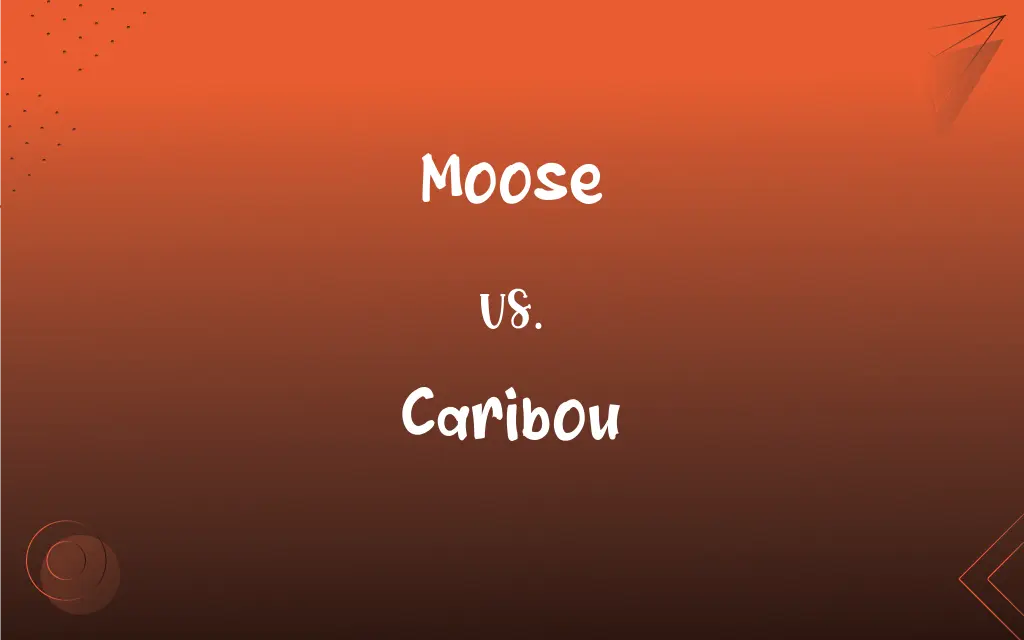Moose vs. Caribou: What's the Difference?
Edited by Aimie Carlson || By Janet White || Published on January 17, 2024
Moose are large, solitary animals with broad, palmate antlers, primarily found in North America and Europe, whereas caribou, also known as reindeer, are smaller, herd-dwelling animals with branching antlers, found in arctic and subarctic regions.

Key Differences
Moose are the largest members of the deer family, known for their massive size and distinctive, broad antlers. Caribou, on the other hand, are smaller and renowned for their long migrations and unique antlers that both males and females possess.
Moose are typically solitary animals, preferring to live alone or in small family groups. Caribou are social creatures, known for forming large herds, especially during migration seasons. This difference in social behavior marks a significant distinction between the two species.
In terms of habitat, moose are commonly found in the forests of North America and Northern Europe, where they browse on leaves and aquatic vegetation. Caribou are adapted to colder, tundra environments of the Arctic and subarctic, feeding on lichens and other tundra vegetation.
The antlers of a moose are palmate, meaning they are broad and flat, resembling an open hand. In contrast, caribou have branching, beam-like antlers. This difference in antler shape and structure is one of the most visually distinguishable features between the two species.
Reproductive behaviors also differ. Moose have a more solitary mating system, with males competing for females during the rut. Caribou, however, exhibit less intense mating competitions, with males gathering small groups of females during the breeding season.
ADVERTISEMENT
Comparison Chart
Size and Build
Larger, heavier build
Smaller, adapted for long migrations
Social Behavior
Solitary or small groups
Large herds, especially during migration
Habitat
Forests in North America and Northern Europe
Arctic and subarctic tundra regions
Antler Characteristics
Broad, palmate antlers
Branching, beam-like antlers
Reproductive Behavior
Solitary mating system
Males gather small groups of females
ADVERTISEMENT
Moose and Caribou Definitions
Moose
A herbivore, primarily feeding on leaves, bark, and aquatic plants.
The moose lowered its head to feed on the tender shoots near the riverbank.
Caribou
Renowned for their impressive endurance and ability to travel long distances.
The caribou traveled hundreds of miles, showcasing their remarkable endurance.
Moose
Known for its solitary nature, except during mating season.
The solitary moose roamed the forest, a solitary figure against the snow.
Caribou
Both males and females grow antlers, a unique feature among deer.
In the caribou herd, both males and females displayed their impressive antlers.
Moose
An animal adapted to cold climates, often found near water sources.
Near the lake, a moose grazed peacefully, undisturbed by the cold.
Caribou
A deer species known for long migrations and living in herds.
A herd of caribou moved across the tundra, a sight marking the change of seasons.
Moose
A large, solitary deer species with broad, palmate antlers.
The moose wandered alone through the forest, its massive antlers catching the light.
Caribou
Adapted to arctic conditions, caribou feed on lichens and tundra vegetation.
The caribou foraged for lichens, well-adapted to the harsh Arctic environment.
Moose
Noted for its impressive size, the moose is the largest member of the deer family.
Hikers spotted a moose in the distance, dwarfing the surrounding trees.
Caribou
Also known as reindeer, caribou are integral to the culture of indigenous Arctic peoples.
Indigenous peoples herded caribou, relying on them for various aspects of their livelihood.
Moose
A large deer (Alces alces) of northern North American and Eurasian forests, having a broad pendulous muzzle, humped shoulders, and large, palmate antlers in the male.
Caribou
A large deer (Rangifer tarandus) of the Arctic tundra and northern boreal forests, having large hooves and long branched antlers. Subspecies native to Eurasia are usually called reindeer.
Moose
The largest member of the deer family (Alces americanus, sometimes included in Alces alces), of which the male has very large, palmate antlers.
We saw a moose at the edge of the woods.
Caribou
Any of several North American subspecies of the reindeer, Rangifer tarandus.
Caribou
The American reindeer, especially the common or woodland species (Rangifer Caribou).
Caribou
Arctic deer with large antlers in both sexes; called reindeer in Eurasia and caribou in North America
FAQs
Do female moose have antlers?
No, only male moose grow antlers.
Are moose social animals?
No, they are mostly solitary except during mating season.
Where can moose typically be found?
In the forests of North America and Northern Europe.
How large can moose antlers grow?
Up to 6 feet across in some males.
What do caribou primarily eat?
Lichens, grasses, and other tundra vegetation.
What predators do moose face?
Wolves, bears, and in North America, occasionally cougars.
What are caribou also known as?
Reindeer, especially in Europe and Asia.
What is the main diet of a moose?
Leaves, bark, and aquatic vegetation.
Do both male and female caribou have antlers?
Yes, unlike other deer species, both sexes grow antlers.
Can moose swim?
Yes, they are excellent swimmers and often feed in water.
How do caribou migrations affect their ecosystem?
They play a crucial role in nutrient cycling and shaping vegetation.
Are caribou an important cultural symbol?
Yes, especially for indigenous Arctic communities.
What is a caribou's primary habitat?
Arctic and subarctic tundra regions.
Are caribou known for migrating?
Yes, they undertake some of the longest migrations of any terrestrial mammal.
What is the lifespan of a moose in the wild?
Typically 15-20 years.
Do caribou live in the same areas as moose?
Their ranges can overlap, but caribou are more common in northern tundra regions.
Are moose and caribou endangered?
Some populations are at risk, but not all.
How do moose communicate?
Mostly through vocalizations and scent marking.
How do moose and caribou cope with cold climates?
They have thick fur and specialized hooves for snow and wetlands.
Are caribou domesticated anywhere?
Yes, particularly in northern Eurasia by indigenous peoples.
About Author
Written by
Janet WhiteJanet White has been an esteemed writer and blogger for Difference Wiki. Holding a Master's degree in Science and Medical Journalism from the prestigious Boston University, she has consistently demonstrated her expertise and passion for her field. When she's not immersed in her work, Janet relishes her time exercising, delving into a good book, and cherishing moments with friends and family.
Edited by
Aimie CarlsonAimie Carlson, holding a master's degree in English literature, is a fervent English language enthusiast. She lends her writing talents to Difference Wiki, a prominent website that specializes in comparisons, offering readers insightful analyses that both captivate and inform.







































































